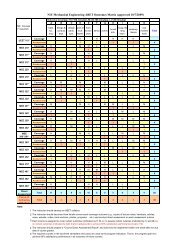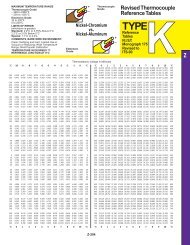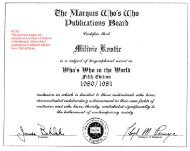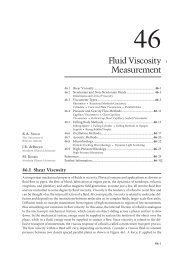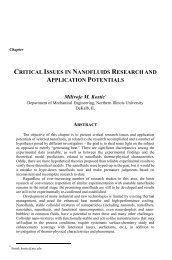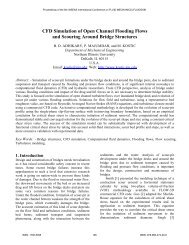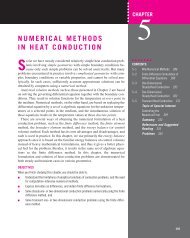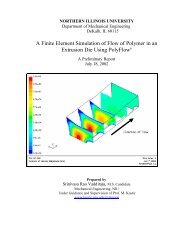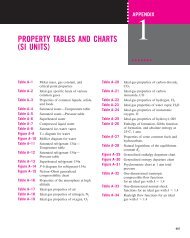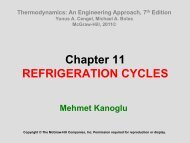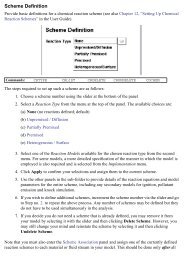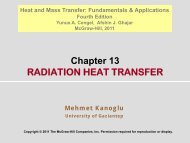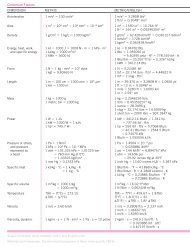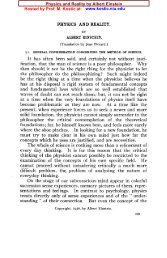Design of Extrusion Dies - Kostic - Northern Illinois University
Design of Extrusion Dies - Kostic - Northern Illinois University
Design of Extrusion Dies - Kostic - Northern Illinois University
Create successful ePaper yourself
Turn your PDF publications into a flip-book with our unique Google optimized e-Paper software.
646 <strong>Design</strong> <strong>of</strong> <strong>Extrusion</strong> <strong>Dies</strong><br />
c. Specification <strong>of</strong> the preland length, the die<br />
land length (note that die land has a constant<br />
cross-sectional pr<strong>of</strong>ile), and the free<br />
surface flow length after the die exit.<br />
2. Thermomechanical properties <strong>of</strong> the polymer<br />
melt: density, heat capacity, and thermal<br />
conductivity.<br />
3. Rheological properties <strong>of</strong> the polymer melt:<br />
non-Newtonian viscosity as a function <strong>of</strong> shear<br />
rate and temperature and=or viscoelastic material<br />
characteristics.<br />
4. Process conditions: inlet melt temperature, mass<br />
flow rate into the die passage (or pressure at the<br />
inlet), die wall temperature, and take-up speed<br />
<strong>of</strong> the extrudate downstream from the die.<br />
The computational domain resembles the real<br />
three-dimensional die geometry and a free surface<br />
flow after the die, where velocity redistribution<br />
(equalization) and stress relaxation take place in a<br />
short distance downstream from the die exit (Fig. 13A).<br />
Because <strong>of</strong> the symmetry <strong>of</strong> the die design, only half<br />
<strong>of</strong> the die passage is modeled (Fig. 13B). A finite element<br />
model <strong>of</strong> the die passage and the free surface<br />
region consists <strong>of</strong> 16,592 hexahedral elements and<br />
19,530 nodes, as detailed elsewhere. [26] The computational<br />
domain must have appropriate boundary conditions<br />
to represent the realistic conditions present<br />
as the melt passes through the die and exits into a<br />
free surface flow (Fig. 13C). The used commercial<br />
CFD program implements an ‘‘inverse extrusion’’<br />
solution algorithm, which computes the shape <strong>of</strong> the<br />
die exit (die land pr<strong>of</strong>ile) required to achieve the target<br />
pr<strong>of</strong>ile dimensions at the exit <strong>of</strong> the free surface<br />
domain. [7] The program solves for the shape <strong>of</strong> the<br />
Fig. 12 U-Pr<strong>of</strong>ile die plates designed with<br />
CFD simulation.<br />
die land that will achieve the target pr<strong>of</strong>ile after die<br />
swell occurs. [7,26]<br />
Cooling Simulation and Calibrator <strong>Design</strong><br />
For optimal design <strong>of</strong> the pr<strong>of</strong>ile extrusion calibrators,<br />
cooling bath, and other cooling accessories, a comprehensive<br />
knowledge about the extrudate heat transfer<br />
process (cooling) is necessary. The biggest challenge<br />
in modeling <strong>of</strong> pr<strong>of</strong>ile extrudate cooling is to specify<br />
properly the boundary conditions in every local part<br />
<strong>of</strong> the cooling equipment. It is possible to approximate<br />
heat transfer coefficients or determine the values<br />
experimentally. [27,28] It may be very difficult to estimate<br />
the heat transfer coefficient in a vacuum calibrator<br />
because it is not possible to predict, without experimental<br />
verification, where the polymer has a good<br />
contact with the cooling wall and what is the influence<br />
<strong>of</strong> a thin layer <strong>of</strong> cooling water being sucked in from<br />
the cooling bath. However, even estimated values can<br />
be used to get a good overall picture <strong>of</strong> the process,<br />
as the polymer materials have a fairly low thermal conductivity.<br />
This means that the obtained results are not<br />
exact, but they can be very useful for design. Therefore,<br />
the modeling and simulation <strong>of</strong> extrudate cooling is a<br />
useful tool for studying the pr<strong>of</strong>ile extrusion cooling<br />
process, as well as for design improvement <strong>of</strong> the<br />
calibrators and other cooling equipment. Other<br />
researchers also indicated that calibration design can<br />
be done to estimate the cooling performance. [29,30] An<br />
illustration <strong>of</strong> the type <strong>of</strong> information that can be<br />
obtained by simulating the cooling <strong>of</strong> the extrudate<br />
is shown by cooling simulation <strong>of</strong> a U-pr<strong>of</strong>ile extrudate<br />
using a commercial simulation program and



